Study on the interaction between the bubble and free surface close to a rigid wall
2020-11-04LIShiminZHANGManCUIPu
LIShimin,ZHANG A-Man,CUIPu
(College of Shipbuilding Engineering,Harbin Engineering University,Harbin 150001,China)
Abstract:A numerical model considering the bubble,rigid wall and free surface is established by using the boundary element method(BEM).We concentrate on the influence between a bubble and the free surface near a rigid wall with 30 degrees to the vertical plane.We conduct this study from two aspects.First,to study the effect of the bubble position,a dimensionless distance parameter is delimited:γh denoting the distance between the initial bubble and the vertical plane crossing with the free surface and the rigid wall.We find that for large-scale bubbles,two liquid jets form at the collapsing stage of the bubble,and a change in the height of the free surface is found to rely onγh.At smallγh the free surface reaches its peak height on the rigid wall,while the peak occurs above the bubble at relatively largeγh.Second,we simulate the behavior of the bubble and free surface under different bubble scales,and we find that the effect of bubble scale on the free surface is mainly reflected in the height of the free surface above the bubble;this height increases continuously when the effect of the bubble scale is relatively great,whereas increases first and then decreases when the effect of the bubble scale is relatively small.
Keywords:bubble dynamics;free surface;fluid-structure interface
0 Introduction
The coulpling effect between a bubble and free surface has been a hot spot in bubble dynamics as its important and common applications in underwater explosions,ultrasonic cleanings[2-3],ocean explorations[4-6]and cavitation erosions[7-10].Considerable studies have been conducted by pioneers[1,11-15],and feature physical phenomenon are observed including the high water spike,high speed liquid jet,and cavitation zones under the free surface.In these works,researchers pay attention to the interaction near a single free surface,but they rarely take the surrounding structure into consideration.However,in many applications it is difficult to avoid the existence of the surrounding structure,and this would cause obvious changes in behaviors of the bubble and the free surface.In military fields,the existence of the hull would lead to the change in the direction of the liquid jet,causing damage to the structure;in ultrasonic cleaning,it is this interaction among the bubble and the structure that makes the impurities cleaned;in the ocean exploration,the vessels would influence the signal of air guns.
Numerical studies in the interaction between a bubble and the free surface have been conducted in recent decades,in which the most popular simulation method may be Finite Volume Method[16-17];but studies concentrate more on those cases in an axial symmetrical system as a result of the unacceptable calculation time of three-dimensional cases.Therefore,in this paper we employ a highly efficient and accurate numerical method(boundary element method,called BEM).Studies on BEM generated rich results in recent decades[18-20].In terms of the issue in this paper,Blake studied the jet characteristics of bubbles and the behaviors of the water pike in Refs.[11-12,21-22],finding that the liquid jet directs away from the free surface accompanied by obvious downward transitions of the bubble.And similar works were performed in large number of literatures[14,23-28].In terms of the effect of the rigid structure,the existence of the rigid wall makes the liquid jet impact the liquid between the bubble and the wall,and the behaviors of a bubble under a single rigid wall have been studied and analyzed[13,15,29-32]intensively.However,for the cases in which the rigid wall and the free surface are all considered,relatively few studies are reported.It is worth mentioning that those cases are very common,particularly for ocean engineering such as underwater explosions and the air gun prospecting.In the military field,the aim of the underwater explosion is the hull,so the effect of the structure cannot be ignored;in this condition the structure would not only change the dynamics characteristics of the bubble,but also influence the behavior of the free surface as a result of its contact with the free surface,and affect the load of the whole fields furtherly.In the air gun prospecting,the effect of the prospect vessel is not expected to exist,as it changes the signal of the pressure waves generated by the pulsation of the large scale bubble;the correct pressure signal is the key of exploring the resources in the sea bed,so it seems essential to reveal the mechanisms in the interaction among the bubble,the rigid wall and the free surface.In addition,in other applications such as ultrasound cleanings and cavitation erosions,the existence of rigid wall is not uncommon.Only we understand the underlying mechanisms deeply could we take advantage of the applications better.
In modelling the dynamic behavior of bubbles under a rigid wall and a free surface using BEM,some difficult problems occur when the rigid wall touches the free surface.The treatment of the interface of the wall and free surface is a challenging problem.In recent studies,some works are conducted considering the structure in the literature[33-34].They use the‘double node method’to code with the fluid-structure interface.There is no doubt that it is instructive for our works.In the work of Liu and Zhang[34],the interaction among the bubble,the free surface and the hull is modelled,the rigid wall is perpendicular to the initial free surface and the bubble is far away from the free surface;therefore,the motion of the free surface is not obvious.Liu and Wang[35]employed the mirror method to deal with it;in their works,they studied those cases in which the inclination angle of the rigid wall(relative to the vertical plane)is within 10 degrees,finding a hump close to the flaring wall,and a trough close to a falling boundary,but for larger inclination of the rigid wall the studies are not conducted and the analysis on the free surface is only qualitative.So,it is necessary to study the interactionwhen the inclination of the rigid wall is great and the depth of the bubble is smaller.
Therefore,there are two issues to be studied and discussed.First,we need to apply the‘double node method’to the cases in which the rigid wall and the free surface are all considered and the rigid wall has greater inclination;second,we need to reveal the underlying mechanisms deeply, especially for the dynamic characteristics of the free surface.In this paper,we firstly establish a numerical model using BEM to simulate the interaction of the bubble,rigid wall and free surface.We set the inclination angle(relative to the vertical plane)at 30 degrees,and we chose this angle mainly because of numerical stability, which is instructed below.We then analyze and discuss the behavior of bubbles and boundaries,concentrating on the behavior of the free surface.For large scale bubbles,the buoyancy has an obvious influence on the bubble,and two high pressure zone on the top side and bottom of the bubble forms,leading to two liquid jets.We find that the height of the free surface depends on its zones;the behavior of the free surface on the rigid wall changes withγhobviously,especially at smallγh.For relatively small scale bubbles,only one downward jet occurs during the collapsing phase;with the increase in the bubble scale,the effect of the bubble on the free surface becomes more obvious,particularly for the free surface directly above the bubble,but the effect on the free surface on the rigid wall seems weak.
1 Numerical model
1.1 Physical model
The physical model we need to study is shown in Figure 1.The blue solid circle represents a bubble.The solid red line represents the rigid wall,and its position and shape remain unchanged throughout the calculation process.The solid green line represents the initial free surface,and at the initial moment the water surface is calm without fluctuations.The angle between the free surface and the rigid wall surface is 120 degrees(the reason for the selection of this angle is described in the next section).The coordinate system is set as shown by the red arrows in the figure.The origin point is situated at the initial position of the bubble;y-axis points to the right;z-axis points vertically upwards.The coordinate system keeps to right-hand rule.
1.2 Basic theory
Based on the potential theory[11,21],the velocity potential satisfies Laplace equation.In the boundary element method (BEM),the boundary integrate equation[13,36]is employed to discretize the interfaces as following:

whereφrepresents the velocity potential,λis a bearing coefficient[36-38]generating on the process of deriving equation(1);G is Green function setting as 1/r(r is the distance between the calculating node and another discretized node);d s is the area of a discretized element.
In the calculation,all the physics features are dimensionless to make the study universal (the maximum radius of bubbles Rm,the hydrostatic pressure p∞at the position of the initial bubble,and the fluid densityρ are set as the reference length,pressure and density respectively).For 2,4,6-Trinitrotoluene explosives(called TNT explosives),Rmcan be obtained according to the empirical formula Rm=3.38[W/(H+10)]1/3(W is the weight of the explosive,and H is the initial depth)[39].According to these three basic feature quantities,the reference time can also be given t*=Rm(ρ/p∞)1/2[40].In our cases,nodes on boundaries,including the bubble,the rigid wall and the free surface need to satisfy Bernoulli equation[36,38,41].The specific forms are as the equation(2),


δin the equation(2)and(3)is buoyancy parameter.It is used widely in the study of bubble dynamics[11-13,33],denoting the scale of the bubble scale.The later studies on the influence of bubble scale are based on this parameter.
In this paper,the pressure inside the bubble is set to be uniform,and we give the expression of the pressure of the gas according to the adiabatic assumption[35,41-42]:

whereεis a strength parameter denoting the initial pressure inside the bubble;κis the ratio of specific heats.V0and V denote the initial volume and current volume of the bubble respectively.
We give the mesh distributions of the boundaries in Figure 2.In the regular area near the interface of the free surface and the rigid wall,we use denser structured grids to ensure the accuracy of the simulation,and the rest of the area is with unstructured grids.In the process of simulations,we refer the work of Zhang and Liu[40]to guarantee the quality of meshes.The angle between the rigid wall and the free surface is 120 degrees.This is because if this angle is larger,the behavior of the free surface will be too violent,which will cause very serious numerical instability and this is beyond the scope of this article.For smaller angles,the previous researchers have studied in detail using numerical and experimental methods as described in the introduction.

Fig.2 The mesh distributions of the boundaries图2 边界上的网格分布
According to the above theory,we can calculate the shape of the bubble,the rigid wall and the free surface at different moments.As for the calculation of the pressure and velocity of the flow field,we use the‘indirect boundary element method’[4,5,33,35],which is a very widely used and very mature method in potential flow theory.We mainly use it to explain the dynamic behavior of the bubble and free surface.In the calculation process,we firstly distribute the calculation points evenly in the rectangular area around the bubble containing the free surface and the rigid wall,and then select the points in the water outside the bubble for calculation.We refer to Liu’s work[35]for the specific implementations.
1.3 The double-node method for the nodes on the fluid-structure interface
For those nodes on thefluid-structure interface,the velocity of the nodes needs to satisfy the boundary conditions of the rigid wall and the free surface simultaneously.Double-node method is employed to deal with this problem,and the detailed ways are as following:
Firstly,we consider the node on the interface as two nodes,so in the process of discretizing the equation(1),the two nodes would be treated separately:

where the f,w,jf,jwrepresent the nodes in the free surface,the rigid wall,the interface considering to be on the free surface,and the interface considering to be on the wallrepresents the normal velocity,andφ represents the velocity potential.
Although the nodes in the interface are considered as two parts,their positions and velocity potential are completely the same.Therefore,the second row and the third row in the above two matrixes are the same.We remove the third row of the two matrices and then addthe second column to the third column on the right matrix,and the equation (5)could be converted as following:

Through the equation(6)we could obtain the normal velocity of the free surface and the velocity potential of the wall.In addition,the velocity of those nodes in the interface need to satisfy the impenetrable condition of the rigid wall and continuousness of the free surface.Thus,we calculate the velocity of those nodes as(7)and(8),

Where vjrepresents the velocity of a node in the interface,and vfis the velocity of the surrounding nodes of the node in the free surface(n is the number of those nodes);nwdenotes the normal vector of the wall.
1.4 Validation of the numerical model
Figure 3 shows the comparison betweenthe results of calculations and the experiments.The solid red line represents the outlines of bubbles and boundaries drawn from the experiment of Zhang[1].The experimental and numerical results are in the same proportion.The initial dimensionless bubble radius is set to 0.27 andεis 20 in order to make the maximum radius of the bubble equal to 1 according to RP equation[41-43].Figure 3(a)gives a comparison at the bubble expansion stage,and Figure 3(b)gives a comparison at the bubble collapsing stage.The shapes of the bubble and the free surface at the expansion stage of the bubble are very consistent with the experimental results.The shape of the bubble in the collapse stage of the bubble is in a good agreement with the experimental result,but there are slight differences in the shape of the free surface between the numerical and the experimental results.This is because in numerical simulation we adopt a‘smoothing technique’[35]for the mesh shape in order to ensure the numerical stability.This technique smooths out the sharp part where the free surface meets the wall surface,which does not affect our study.

Fig.3 Comparison of numerical simulations and experimental results (The gray part represents the results of numerical simulations,and the red solid line represents the experimental results in work of Zhang[1];the initial dimensionless depth of the bubble is 0.9,andγh=1.16,δ=0.052;t*is dimensionless)图3 数值结果和实验结果的对比(灰色部分代表数值模拟的结果,红色实线代表Zhang的的实验结果[1];气泡的初始无量纲深度为0.9,γh=1.16,δ=0.052;t*为无量纲时间)
2 Results and discussion
2.1 Effect ofγh
In order to understand the behavior of the bubble and the free surface,we give the pressure and velocity distributions of the whole fields in Figure 4.In our cases,the initial dimensionless bubble radius is set to 0.09,εis 367,the dimensionless depth of the bubble is 1.1,and the buoyancy parameter of the bubble is set as 0.6,representing a large-scale bubble(equivalent to about 170 kg TNT explosives according to RP equation[42-43].The maximum radius of the bubble Rmis 7.14 m.Thus,the reference length is 7.14 m,and the reference length is 0.72 s).The six frames in Figure 4 show the main features of the bubble and free surface.At the beginning,the bubble expands quickly due to its huge inner pressure,causing the free surface to rise constantly.Note that the free surface close to the wall is a little higher than other zones.As an explanation,the fluids in the vicinity of the rigid wall are extruded,as a result,the surrounding fluids gather here constantly accompanying with upward motions.When the bubble expands to its maximum volume(t*=1.1118),we can see the upper side of the bubble is attracted by the free surface,afterwards the bubble begins to collapse.At the collapsing stage of the bubble,two liquid jets oppose each other.The two pressure gradients in the upper and lower part of the bubble explains these two jets well.An interesting finding is that the height of the free surface touching the wall has exceeded that of other zones at t*=1.5424,and this finding is different from previous research results.In the previous literature[35],researchers found that the height of the free surface directly above the bubble (called water doom[1]as shown at t*=1.1118,and we call it like this in the following)is highest when the angle between the wall and the free surface is small(100 degrees in Liu’s work[35]).This new finding may be the result of the relatively bigger inclination angle of the rigid wall.In the later phase(t*=1.7393,t*=1.7401),the free surface continues to rise up and the two liquid jets strike eventually and a high-pressure zone forms near the collision region of the two jets(t*=1.7401).
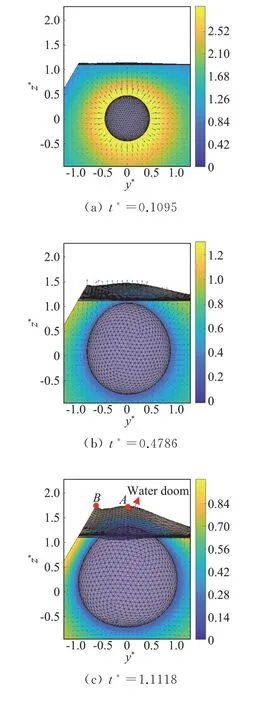

Fig.4 Pressure and velocity distribution of the whole fields at typical moments(the dimensionless depth of the initial bubble is 1.1,andγh =1.1;y*,z*,and t*are all dimensionless.The reference length equals to 7.14 m,and the reference time equals to 0.72 s)图4 典型时刻下整个域内的压力和速度分布(气泡的初始无量纲深度为1.1,γh=1.1,y*、z*和t*都是无量纲的,参考长度为7.14 m,参考时间为0.72 s)
In Figure 4,note that a phenomenon worth observing is the shape of the free surface,so we provide the side view(the line of sight is at a 45-degree angle to the x-y plane)at typical moments in Figure 5.Different parts of the free surface show various dynamics characteristics in the collapsing phase of the bubble,particularly at t*=1.6597,on the rigid wall the free surface achieves an interesting shape that is high at middle side and low on both sides.The zone a little far away from the bubble’s center caves obviously.As an explanation,in the bubble expansion phase the fluids tend to gather at the middle part leading to the larger velocity of fluids here.At the bubble collapsing stage the fluids at the middle part continue to rise up due to inertia,and the upward motion trend of fluids at both sides gradually decreases,eventually disappears.
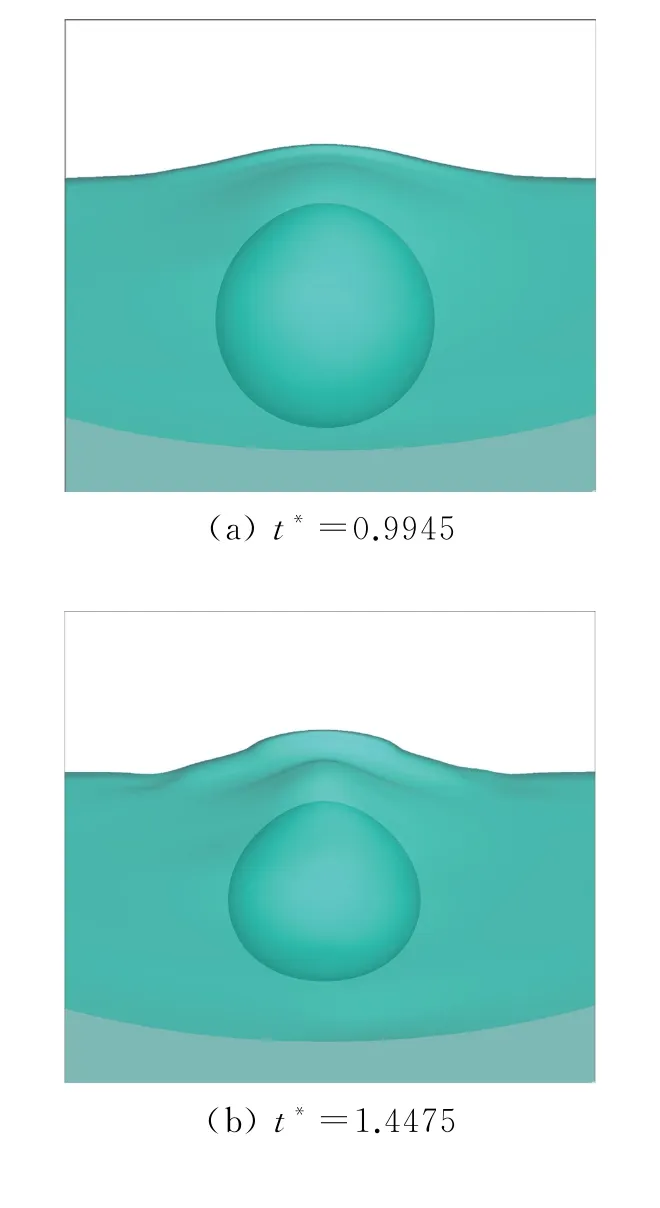
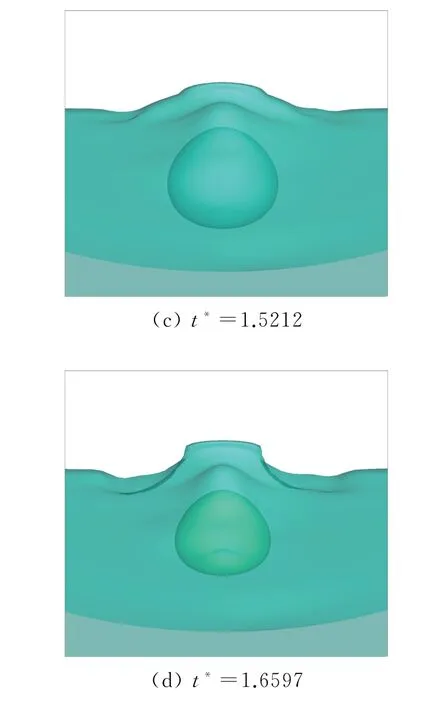
Fig.5 The side view of the free surface(t*is dimensionless.The reference time equals to 0.72 s)图5 自由面的侧视图(t*是无量纲的,参考时间为0.72 s)
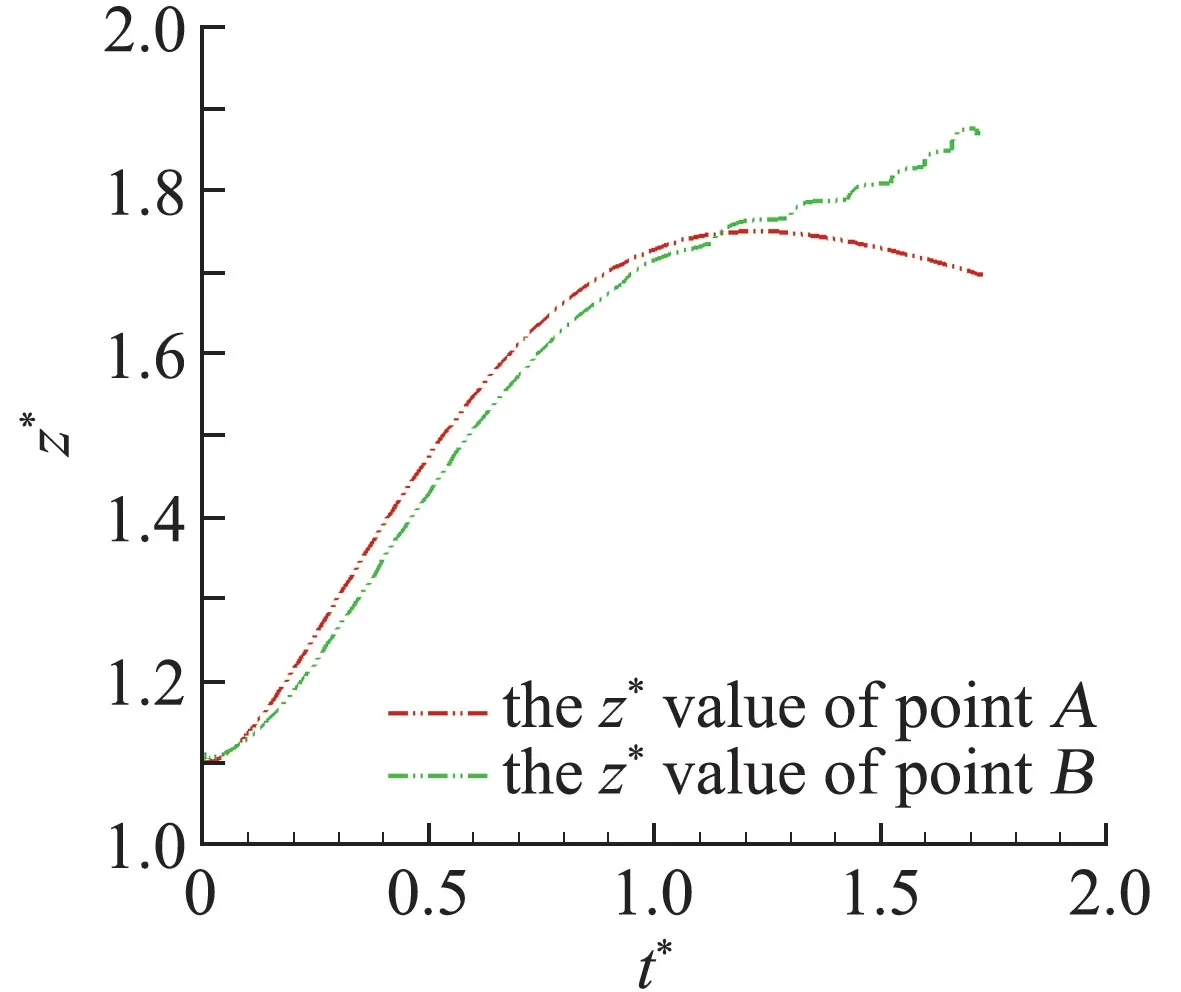
Fig.6 The evolution of the heights of the point A and B (z*and t*are all dimensionless.The reference length equals to 7.14 m,and the reference time equals to 0.72 s)图6 A 点和B 点高度的时历曲线(z*和t*都是无量纲的;参考长度为7.14 m,参考时间为0.72 s)
The behavior of the free surface on the rigid wall must affect the characteristics of the rigid wall in practical applications,so we conduct quantitative studies on it.In Figure 6,we provide the time histories of the heights of point A and point B (the point A represents the highest point of the water doom,and the point B represents that on the rigid wall on the y-z plane as shown in Figure 4(t*=1.1118))to study the behavior of the free surface.In the bubble expansion phase the height of point B is a little lower than that of point A due to the larger distance to the bubble,but it begins to exceed that of point A at t*=1.1118.Afterwards the gap between the heights of the point A and point B increases constantly,and the height of point A shows a slight decrease.In previous literatures[11,14,28,35],researches show that the height of the water doom(equivalent to the height of point A)increases constantly on the bubble collapsing stage under a singlefree surface or a small inclination angle between the free surface and rigid wall.However,in our researches the rising free surface on the rigid wall generated some effects on the changes of the height of point A.This effect may be also attributed to the larger inclination of the rigid wall.
In previous works[1,35],the height of the free surface near the rigid wall does not exceed the height of the water doom.Therefore, we perform parameter analysises on this phenomenon to see if it occurs at any distance to the rigid wall.We give the time histories of the heights of the point A and B atγh=1.0,1.1,1.15,1.25 in Figure 7.From the picture,the height of the point A does not change obviously.However,the free surface on the rigid wall continues to rise up after the bubble reaches its maimum volume atγh=1.0,1.1,while goes down atγh=1.15,1.25.This indicates that the phenomenon that the height of the free surface near the wall exceeds the height of the water doom occurs only within a certain distance(at leastγh≤1.1 for this study).In addition,the height of the point A reaches its maximum almost at the same moment whenγh=1.15,1.25.The height of the point A atγh=1.25 is smaller than that atγh=1.15 due to the larger distance to the bubble.The moment at which the height of the point B exceeds that of the point A whenγh=1.1 is later than that whenγh=1.0.
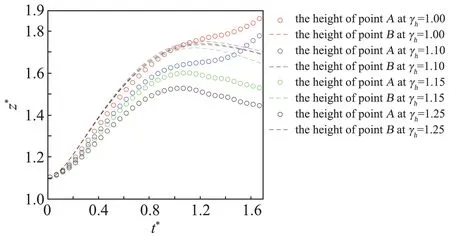
Fig.7 Evolutions of the heights of the two water spikes at γh=1.0,1.1,1.15,1.25(z*and t*are dimensionless)图7 两个水冢高度在γh=1.0,1.1,1.15,1.25时的时历曲线(z*和t*都是无量纲的)
2.2 Effect ofδ
In the previous section the buoyanciy parameters of bubbles are all set to 0.6,which represents a very largescale bubble.However, as described in the introduction,there are still many situations in which small-scale bubbles interact with the free surface and rigid wall in practical applications,such as ultrasonic cleaning.Therefore,in this section we change the buoyancy parameters of bubbles and explore the effects of buoyancy.
Figure 8 provides the pressure and velocity distributions of the whole fields for a typical case(γh=1.5 and the dimensionless depth of the initial bubble is 1.5),in which the buoyancy of the bubble is negligible(δ=0).In the bubble expansion phase,the free surface is lifted by a pressure gradient between the bubble and the free surface.Compared with the large-scale bubble in the previous section,the biggest feature in this condition is that only a downward liquid jet is generated.This is because the size of the bubble is negligible,causing the pressure difference between the upper and lower bubbles generated by the bubble scale to be zero.In the late phase the height of each part of the free surface decreases,which is the result of the larger depth andγh.

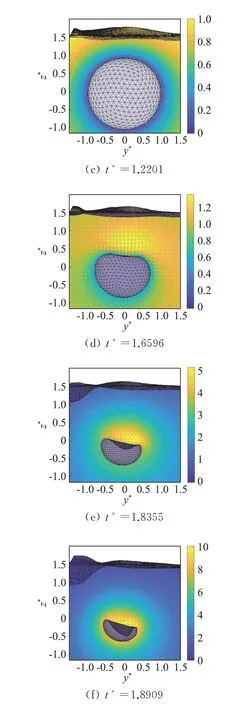
Fig.8 The pressure and velocity distribution of the whole fields at typical moments(the dimensionless depth of the initial bubble is 1.1,andγh=1.1;y*,z*,and t*are all dimensionless)图8 典型时刻下整个域内的压力和速度分布(气泡的初始无量纲深度为1.5,γh=1.5,y*、z*和t*都是无量纲的)

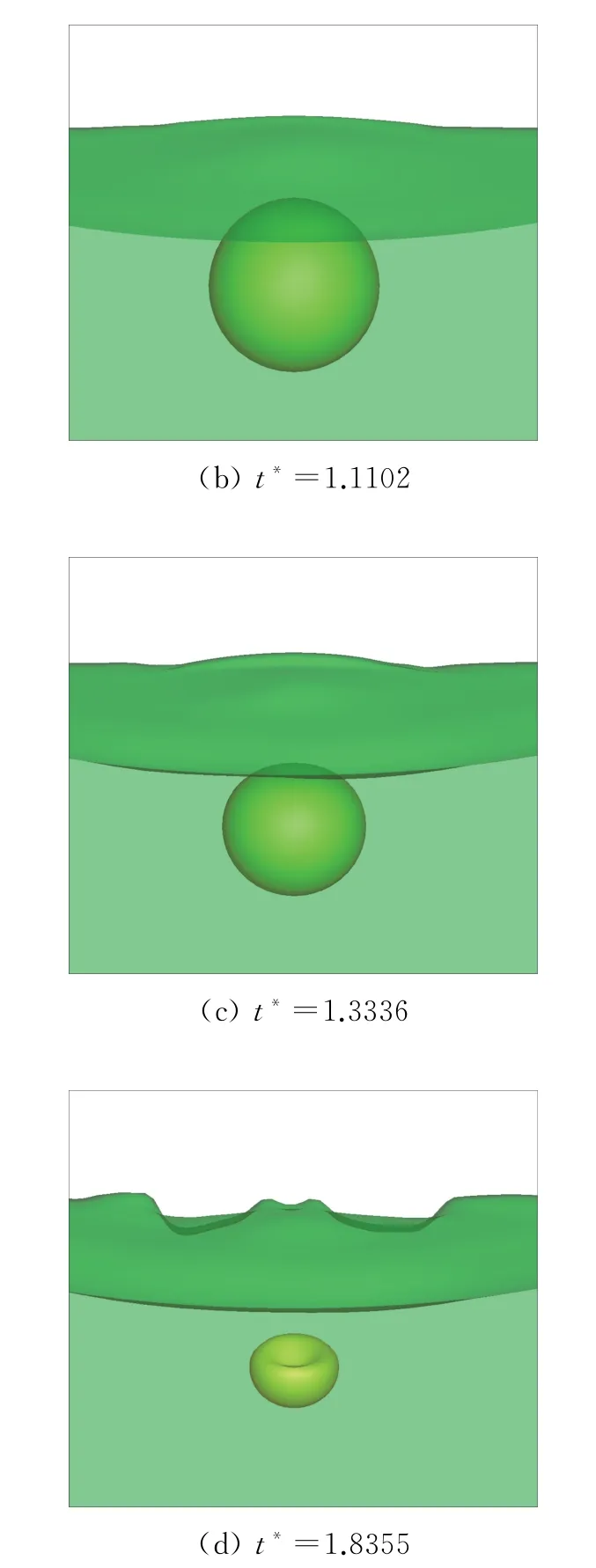
Fig.9 The side view of the free surface(t*is dimensionless)图9 自由面的侧视图(t*是无量纲的)
To know the behavior of the free surface on rigid wall,we give the side view(the line of sight is at a 45-degree angle to the x-y plane)at typical moments in Figure 9.In the expansion phase of the bubble,the change of the free surface is relatively mild because the bubble is relatively far away from the free surface and the rigid wall.However,an interesting phenomena appears in the bubble collapsing phase.A small recessed area appears in the center area of the free surface and two huge dimples appear at the ends at t*=1.8355.
Next we focus on the effect ofδ on the dynamic behavior of the free surface.In order to study the influence of the buoyancy of the bubble,we plot the curves of the height of point A and B (delimited in Figure 4)with respect to t*at differentδin Figure 10.The heights of the free surface on the rigid wall are very consistent under different buoyancy values,but the height of the water doom changes significantly with the change inδ.The height of the water doom caused by large-scale bubbles is obviously larger than that by small-scale bubbles.As the effect of buoyancy increases,the speed of the water doom dropping deccreases at the bubble collapsing stage.This shows that large-scale bubbles have a greater impact on freesurfaces,mainly reflected in the water doom.
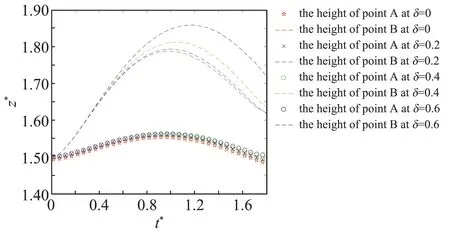
Fig.10 The evolutions of the heights of the two water spikes whenδis 0,0.2,0.4 and 0.6(z*and t*are all dimensionless)图10 当δ 为0、0.2、0.4和0.6时两个水冢高度的时历变化对比
3 Conclusions
In this paper,we use the BEM to simulate the behavior of a bubble and a free surface near a rigid wall with a certain inclination angle.Numerical rsults including the pressure and velocity distributions of the fields and the height of the free surface can give informative conclusions:
For large-scale bubbles,two pressure gradients above and below the bubble cause two liquid jets,while the small-scale bubble produces only a downward jet.We give the change of two peak heights of the free surface with respect to time at differentγh.We find that the height of the free surface on the rigid wall is greater than that of the water doom (at leastγh≤1.1 for our study).Atγh≥1.15,the height of the free surface on the rigid wall decreases,and it is lower than that of the water doom.
By studying the interaction at different scales of bubbles,we find that large-scale bubbles have a greater effect on free surfaces,and this effect is mainly reflected in the height of the water doom.After the dimensionless time is greater than about 0.4,the height of the water doom caused by large-scale bubbles will have a larger value and a smaller reduction speed.
Acknowledgements:This work is supported by the National Natural Science Foundation of China(11872158).We are grateful to Dr.Liu Yunlong for the help in calculating the pressure in the flow field.
